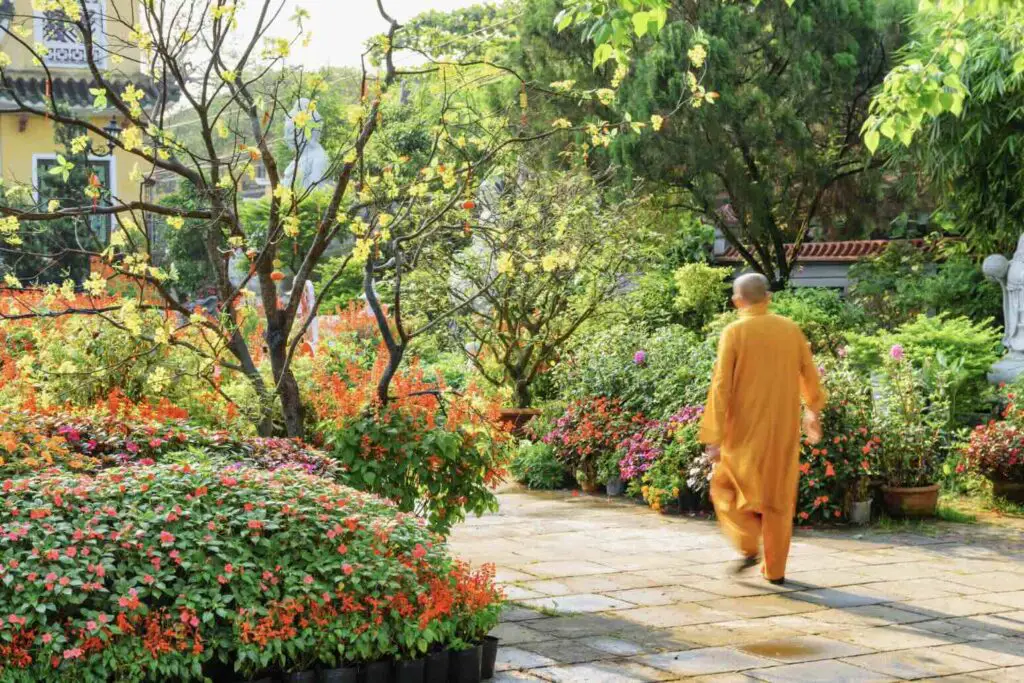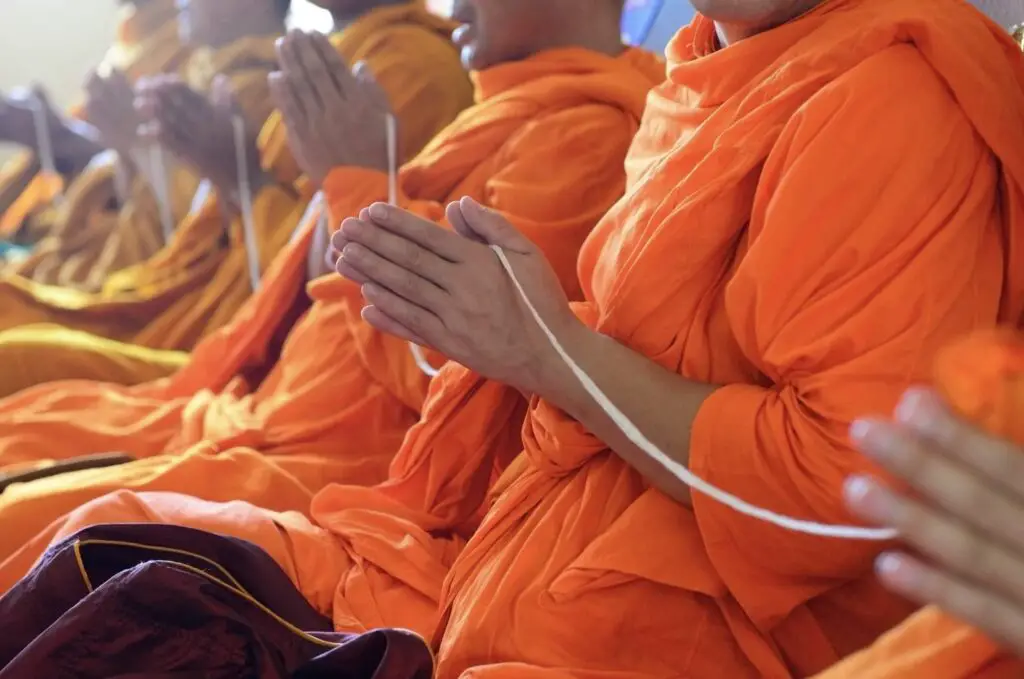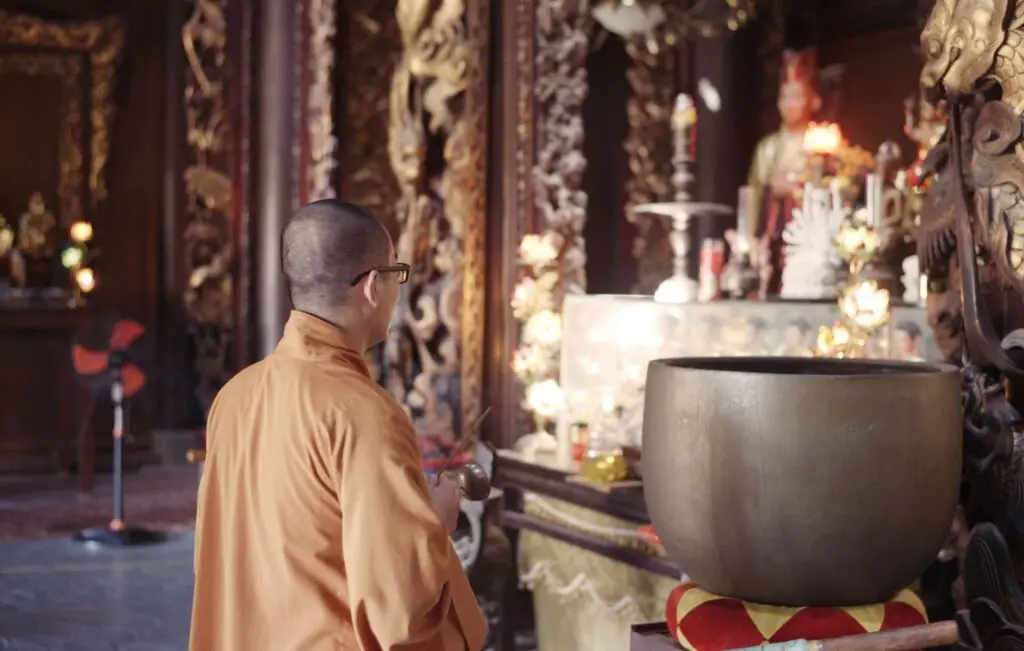Vietnam’s spiritual landscape is painted with the broad strokes of Buddhism, a tradition woven into the fabric of the nation’s identity over centuries. This narrative journeys through the evolution of Vietnamese monasticism, tracing its roots from early influences to its contemporary manifestations.
As we navigate this historical and cultural path, we encounter the adaptability and resilience of monastic practices amid societal shifts and technological advancements.
Table of Contents
- The Historical Context Of Vietnamese Monasticism
- Monwellbeinge: Practices And Daily Routines
- The Intersection of Monasticism and Society
- Modern Challenges And Adaptations
- Related Questions
The Historical Context Of Vietnamese Monasticism
Vietnam first felt the touch of Buddhism through maritime trade routes with India, followed by Chinese influence during occupation and cultural exchange. Initially, Vietnamese Buddhism and monastic practices stayed close to their Chinese counterparts, embracing Mahayana Buddhism’s rituals and philosophy. Early monasteries were not just spiritual retreats but also centers for social service, providing education, healthcare, and support to local communities.
The Ly dynasty, beginning in the 11th century, marks a pivotal era for Vietnamese monasticism. Royal patronage under the Ly dynasty saw Buddhism adopted as a state religion, leading to a surge in the construction of pagodas and monasteries throughout the country. Monks gained significant influence, not only as spiritual leaders but also as advisors to the king and as scholars.
One distinct development during this period was the role of monk-scholar Vạn Hạnh, who laid foundational works integrating Buddhism into Vietnamese ethos. He nurtured a national identity that saw Buddhism weave into the fabric of societal values rather than existing on the periphery.
Starting in the 13th century, during the Tran dynasty, Vietnam faced Mongol invasions, leading to a more militarized role for some monastic orders. Monks actively participated in national defense, exemplifying the adaptability of monastic roles beyond spiritual teaching. Post-invasion, this period intensified the Vietnamization of Buddhism, fostering the growth of uniquely Vietnamese Buddhist practices and the first forms of Zen Buddhism in Vietnam.
The focus of Vietnamese monasticism shifted significantly with the spread of Theravada Buddhism from neighboring Cambodia and Laos in the 15th and 16th centuries. This influence introduced more contemplative practices and emphasized individual enlightenment, which resonated with many Vietnamese Buddhists. It departed from the Mahayana doctrine and promoted a more straightforward, meditation-focused approach to Buddhism that appealed to the ordinary people.
Monastic practices continued to evolve, with the 18th and 19th centuries seeing an uptick in synthesizing various Buddhist traditions. During this period, he also witnessed the emergence of critical figures like Hải Triều Âm, who sought to reform Vietnamese Buddhism by advocating for a return to what he perceived as its original principles. His efforts highlighted the tension between maintaining tradition and adapting to contemporary needs.
In the 20th century, the French colonization and later conflicts in Vietnam drastically affected monastic life. Monasteries served as sanctuaries in times of turmoil but were also targeted during periods of repression. The emergence of socially engaged Buddhism under Thich Nhat Hanh in the mid-20th century showcased another evolution of Vietnamese monasticism, stressing mindfulness, compassion, and activism.
Today, monasticism in Vietnam offers a vivid tapestry of ancient influences and modern adaptability. Monasteries are developing programs that address current global concerns such as environmentalism, education, and social welfare while retaining their core spiritual practices. This ongoing evolution reflects the enduring vitality of Vietnamese monastic life and its capacity to contribute to society’s spiritual and temporal well-being.

Monwellbeinge: Practices And Daily Routines
Embodying serenity and mindfulness, Vietnamese monks begin their day long before the sun rises over the paddy fields and bustling cities. Waking up at 4:00 AM, they engage in the first meditation session of the day. This critical practice, sitting in silence, often lasts for an hour, immersing them in deep reflection and breathing exercises that set a peaceful tone for the day ahead.
As dawn breaks, the monks participate in a walking meditation. Encouraged to be fully present in each step, they practice mindfulness in motion around the monastery grounds, among nature, to cultivate calm and awareness throughout the day.
Following early morning meditation rituals is the chanting of sutras. This practice involves reciting ancient Buddhist texts in unison, an uplifting experience that strengthens communal bonds and reinforces the teachings of the Buddha. The rhythmic chant echoes through the temple halls, permeating the air with a sense of spirituality.
Breakfast is typically taken in silence around 6:00 AM. The meal, usually consisting of rice, vegetables, and soup, is approached with mindfulness. Monks view eating as a meditative practice, focusing on the origins of the food and expressing gratitude for the nourishment provided.
The heart of morning hours is dedicated to personal and communal duties. Some monks tend to the temple’s garden, growing vegetables that sustain their simple vegetarian diet, while others clean the monastery grounds or study. Study sessions encompass religious texts to deepen their understanding of Buddha’s teachings and sometimes academic subjects for monks engaged in educational outreach.
By midmorning, certain monks prepare for ‘Binh thuc,’ or alms rounds. Dressed in their traditional saffron robes, they walk barefoot through local communities where laypeople offer food and necessities. This practice exemplifies humility and the interdependent relationship between the monastic community and laypeople, embodying a living interaction of giving and receiving with gratitude and respect.
Returning from beggars rounds, the monks share lunch, their main meal of the day, again eaten in silence while practicing mindfulness. Post-lunch is reserved for resting or personal time, allowing monks to reflect, read, or meditate.
The afternoon continues with duties or further study sessions. Many monks also teach Buddhism to laypeople or mentor younger novices in their spiritual journey. This interaction illuminates their role as spiritual guides within the community, fostering an environment where knowledge and wisdom are freely passed down.
As evening approaches, another session of meditation before dinner helps one recall the day’s events and ground oneself again in mindfulness. Their day’s final main activity includes participating in group meditation or sutra chanting in the temple hall, revitalizing their commitment to their spiritual practices and community.
Their day concludes much like it began, with reflection and preparation for the well-deserved rest that follows. Quietly retiring to their simple living quarters by 10:00 PM, they bring close another day lived fully in mindfulness, service, and devotion to their faith.
What stands out is the structure of their activities and the ethos that permeates their every act—mindfulness and compassion. This devotion embodies the Buddhist belief that everyday actions, no matter how mundane, are opportunities to cultivate understanding and love, steering close to enlightenment in each mindful step and compassionate gesture.

The Intersection of Monasticism and Society
Vietnamese monks actively participate in social reconstruction projects, especially after natural disasters like floods and typhoons, demonstrating their commitment to compassion and community welfare. They organize relief efforts, distribute food and clothes, and provide shelter, offering immediate support and solace to affected populations.
Education remains a cornerstone of the monks’ engagement with society. Many monasteries run free schools for underprivileged children and adults, ensuring access to education despite financial constraints. The monks teach various subjects, from traditional Buddhist teachings to modern academic disciplines, emphasizing moral and ethical development alongside academic progress.
Healthcare services, including free clinics run by monastic communities, support rural areas with limited medical infrastructure. Monks and volunteers offer treatments, traditional medicine, and health education, embodying the Buddhist principle of alleviating suffering.
Environmental conservation is another significant area where monks contribute to societal well-being: initiatives include well-being planting, wildlife preservation, and advocacy against environmental degradation. Monastic commitment to living harmoniously with nature translates into active involvement in ecological sustainability efforts.
Social justice issues, such as advocating for peace and human rights, reflect the monks’ broader societal engagement, aligned with Buddhist teachings on compassion and non-violence. They participate in peace marches, human rights campaigns, and interfaith dialogues to address social injustices and build bridges across communities.
Balancing the demands of social activism with the monks’ spiritual practices can be challenging. Critics sometimes question whether extensive social engagement detracts from their religious duties. However, many monks view their active participation in societal issues as an extension of their spiritual mission.
Monastic communities face scrutiny and challenges in navigating their roles amid political sensitivities, particularly when their social initiatives intersect with governmental interests or policies. They strive to maintain their religious integrity while engaging in social activism within a complex political landscape.
In offering addiction recovery services, monks extend their compassion to individuals struggling with substance abuse, providing support programs grounded in Buddhist principles. These services demonstrate a practical approach to alleviating contemporary social issues, embodying the compassionate spirit of Buddhism.
Through intercultural exchange programs, Vietnamese monks forge connections with global Buddhist communities and other religious groups. These exchanges promote understanding, foster mutual respect, and inspire collaborative efforts toward common humanitarian goals.
Despite periodic tensions stemming from their engagement in socially and politically sensitive areas, monks in Vietnam continue to play a vital role in society’s fabric. Their contributions span from providing essential education and healthcare to championing environmental conservation and social justice, embodying a living Buddhism that responds dynamically to the needs of the times.

Modern Challenges And Adaptations
Faced with a skyline increasingly dominated by skyscrapers and the constant beep of smartphones, Vietnamese monks face the enormous task of keeping Buddhism relevant in the face of swift urbanization.
The country’s cities are expanding, swallowing up areas that were once tranquil settings ideal for monasteries. Monks find these urban environments challenging in maintaining the serenity necessary for their practices.
Amidst this urban spread, monks lean into technology, not shying away. They’ve started to harness social media and web platforms to spread the Dharma, reaching audiences far beyond their temples’ gates. YouTube channels, online meditation sessions, and dharma talks via Zoom have become new avenues for these ancient teachings.
As technological trends and globalization reshape societal norms, the monks engage in a delicate dance of modernization while clinging fiercely to their spiritual roots. They find themselves becoming digital nomads, in a sense, balancing online engagements with the solitude of meditation.
Globalization doesn’t only bring challenges but also opportunities for Vietnamese Buddhism. Monks are now part of a large, interconnected world where ideas and practices can be shared across borders. Engagements with Buddhist communities worldwide have sparked exciting discussions around modernizing practices without diluting the essence of Buddhism. Virtual and in-person conferences with international Buddhist communities offer these monks perspectives on how Buddhism is adapting globally.
However, within the monastic and lay communities, there’s an ongoing debate about how much adaptation to modern life is too much. Younger generations raised on quick snippets of information from smartphones ponder if traditional, lengthy dharma talks are outdated. In response, some monks simplify teachings, making them more accessible and relatable while ensuring the core messages remain untouched.
Adaptation also emerges in lifestyle choices reflective of today’s concerns, such as sustainability. Monasteries are increasingly adopting green practices, from solar panels to organic farming, emphasizing a sustainable monastic life that aligns with Buddhist teachings on respect for all living beings.
Despite the whirlwind of changes, the essence of monastic life in Vietnam remains focused on personal enlightenment and societal service. Monks extend their roles into community building and support, recognizing that their spiritual practices can offer sanctuary from the pressures of modern life. Initiatives now range from mindfulness workshops aimed at stress reduction in corporate settings to engaging the youth with interactive Buddhist teachings that utilize modern technology for greater appeal.
In essence, Vietnamese monks are not merely surviving in the modern world; they are actively shaping a form of Buddhism that speaks directly to people’s hearts, navigating the complexities of 21st-century life. They stand as bridges between the ancient and the modern, proving that even in a world that seems to move too fast, the timeless quest for understanding, compassion, and peace has its place.
In essence, the heart of Vietnamese monastic life beats with a rhythm of mindfulness and service, echoing through the corridors of time into the bustling streets of today. Monks stand as custodians of tradition, yet they are also architects of a Buddhism that resonates with the modern human spirit.
Their journey reflects a profound commitment to fostering understanding, compassion, and peace in a rapidly changing world, proving that spirituality remains a vital sanctuary for individuals’ life’s challenges.
At A Bus On A Dusty Road, we talk about everything about history, travel, life, sailing, and ex-pat living. We are all about “Living Life As A Global Citizen.” We explore social, cultural, and economic issues and travel.
We would love to have you be part of our community. Sign up for our newsletter to keep up-to-date by clicking here. If you have any questions, you can contact me, Anita, by clicking here.
Listen to our Podcast called Dusty Roads. You can find it on all major podcast platforms. Try out listening to one of our podcasts by clicking here.
Subscribe to our A Bus On A Dusty Road YouTube Channel filled with great videos and information.
Related Questions
Are Hmong People And Mongol People Related?
The Hmong people are from China and have migrated to southeast Asia, mainly Vietnam, Laos, Thailand, and Myanmar (Burma). The Mongols, also known as Mongolians, live primarily in Inner Mongolia (China) and Mongolia. The Hmong mainly live in the mountains, whereas the Mongols are nomadic herders.
By clicking here, you can discover Are Hmong People And Mongol People Related?
What Happened To The Hmong After The Vietnam War?
When the Vietnam War ended, the Hmong in Laos was in a terrible position; the Hmong fighters were enemies of the present Laotian government and considered “persona non gratis.” Some were forced into labor camps or kicked out of their home and lands. The Hmong eventually made their way to the Laotian – Thai border to try to get into the United States via Thailand.
By clicking here, you can discover What Happened To The Hmong After The Vietnam War?
Are Miao And Hmong The Same People?
Miao is a Chinese term used for the ethnic hill tribes that are Hmong, Hmu, Qo Xiong, and A-Hmao people. If someone says they are Miao, you can not automatically assume they are Hmong as they could be one of these four ethnic classified groups.
By clicking here, you can learn more by reading Are Miao And Hmong, The Same People?

